UGB331 Applying Critical Reflective Practice: Professional Growth
VerifiedAdded on 2023/06/08
|12
|3815
|52
Report
AI Summary
This report evaluates self-reflection as a method for emerging professionals, focusing on formal professional identity within the Chartered Institute of Personnel and Development (CIPD). It reviews the concept of self-reflection, emphasizing its role in analyzing personal thoughts, desires, and feelings, and its impact on understanding core values and professional responsibilities. The research methodology employs reflexivity, analyzing personal data through Gibbs Reflective Cycle and personal data sources such as learning style questionnaires and emotional intelligence surveys. A descriptive research design is used to understand the phenomenon of self-reflection in professional development. The report includes a reflexive practitioner storyboard and a critical incident analysis of a workplace scenario, highlighting the importance of self-awareness and continuous improvement in professional practice. Desklib provides access to similar reports and solved assignments for students.
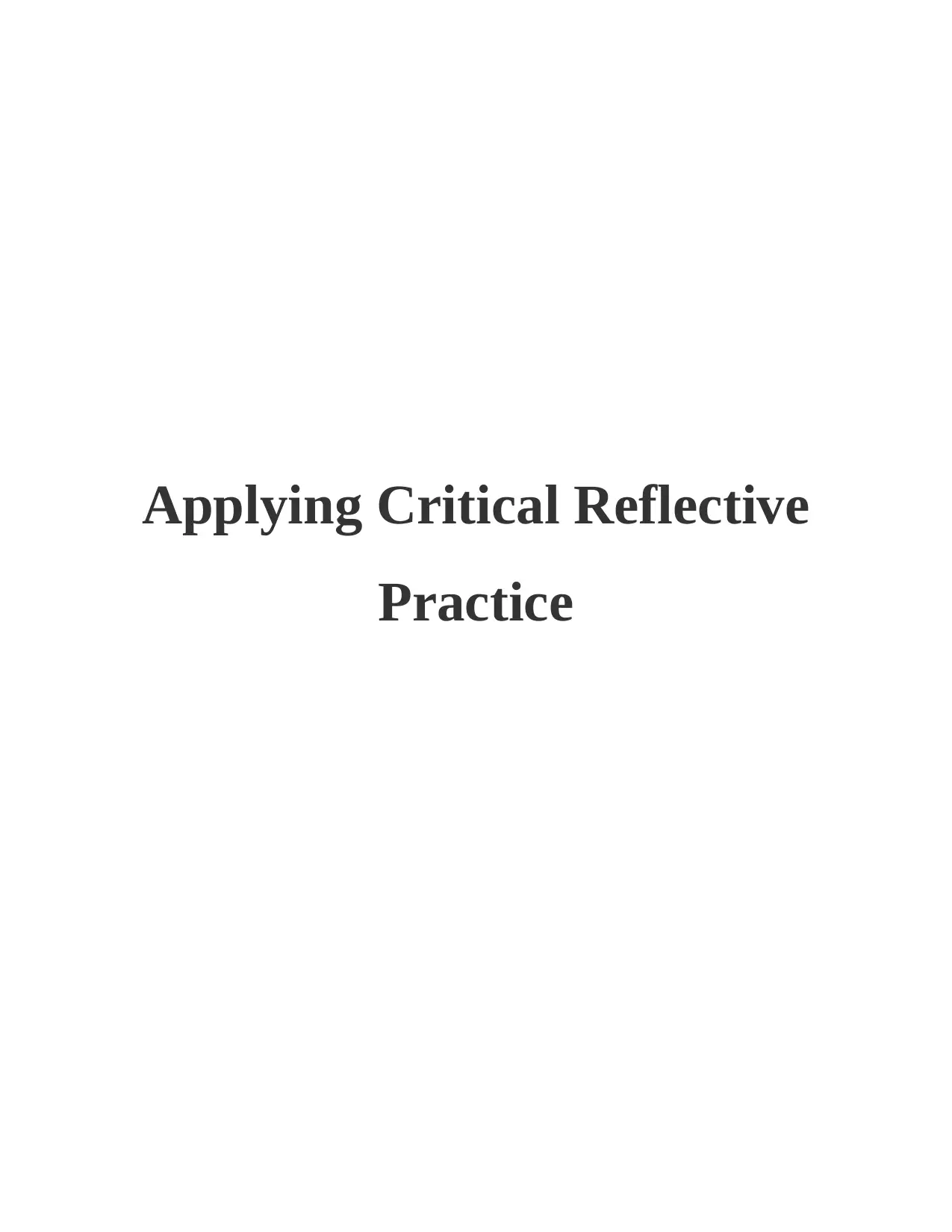
Applying Critical Reflective
Practice
Practice
Paraphrase This Document
Need a fresh take? Get an instant paraphrase of this document with our AI Paraphraser
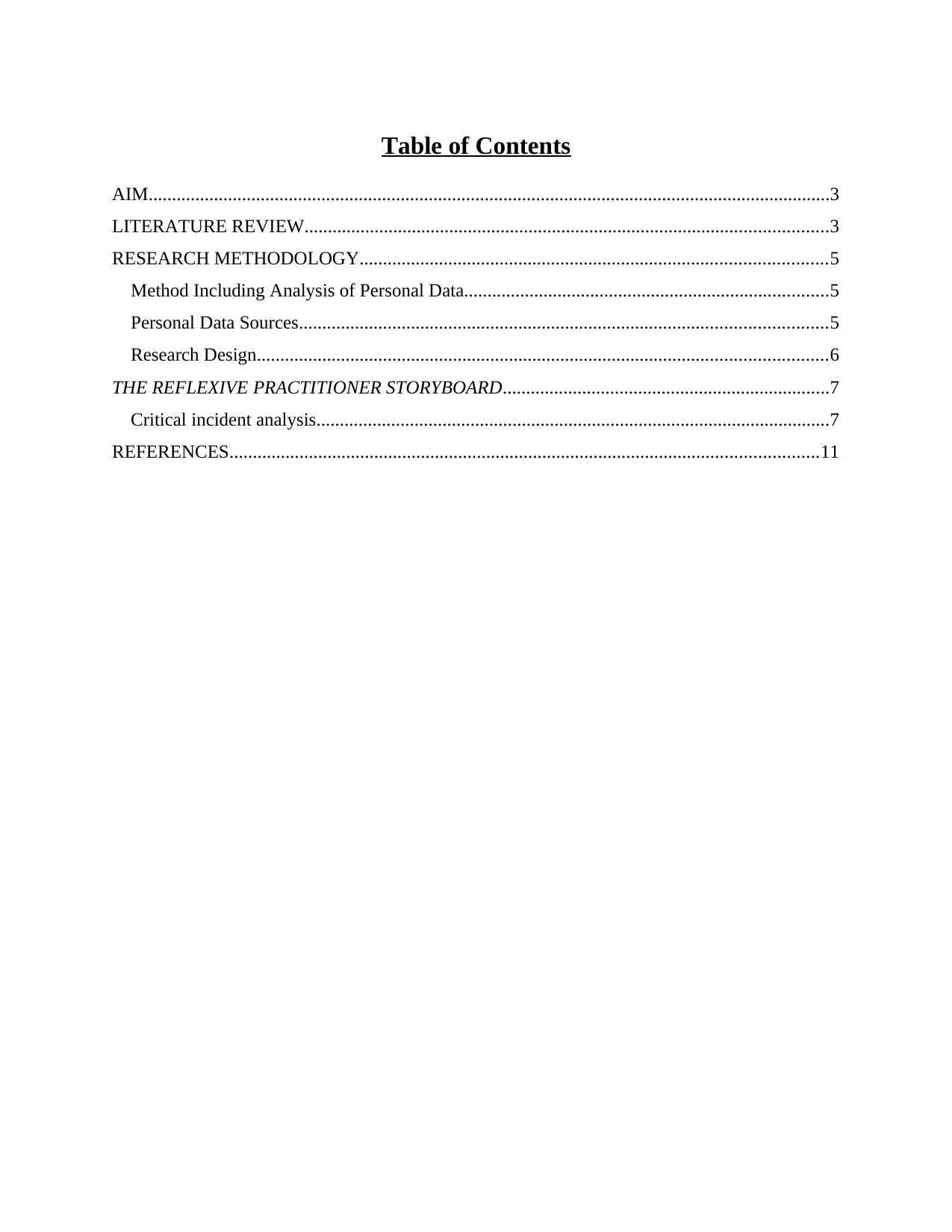
Table of Contents
AIM..................................................................................................................................................3
LITERATURE REVIEW................................................................................................................3
RESEARCH METHODOLOGY....................................................................................................5
Method Including Analysis of Personal Data..............................................................................5
Personal Data Sources.................................................................................................................5
Research Design..........................................................................................................................6
THE REFLEXIVE PRACTITIONER STORYBOARD......................................................................7
Critical incident analysis..............................................................................................................7
REFERENCES..............................................................................................................................11
AIM..................................................................................................................................................3
LITERATURE REVIEW................................................................................................................3
RESEARCH METHODOLOGY....................................................................................................5
Method Including Analysis of Personal Data..............................................................................5
Personal Data Sources.................................................................................................................5
Research Design..........................................................................................................................6
THE REFLEXIVE PRACTITIONER STORYBOARD......................................................................7
Critical incident analysis..............................................................................................................7
REFERENCES..............................................................................................................................11
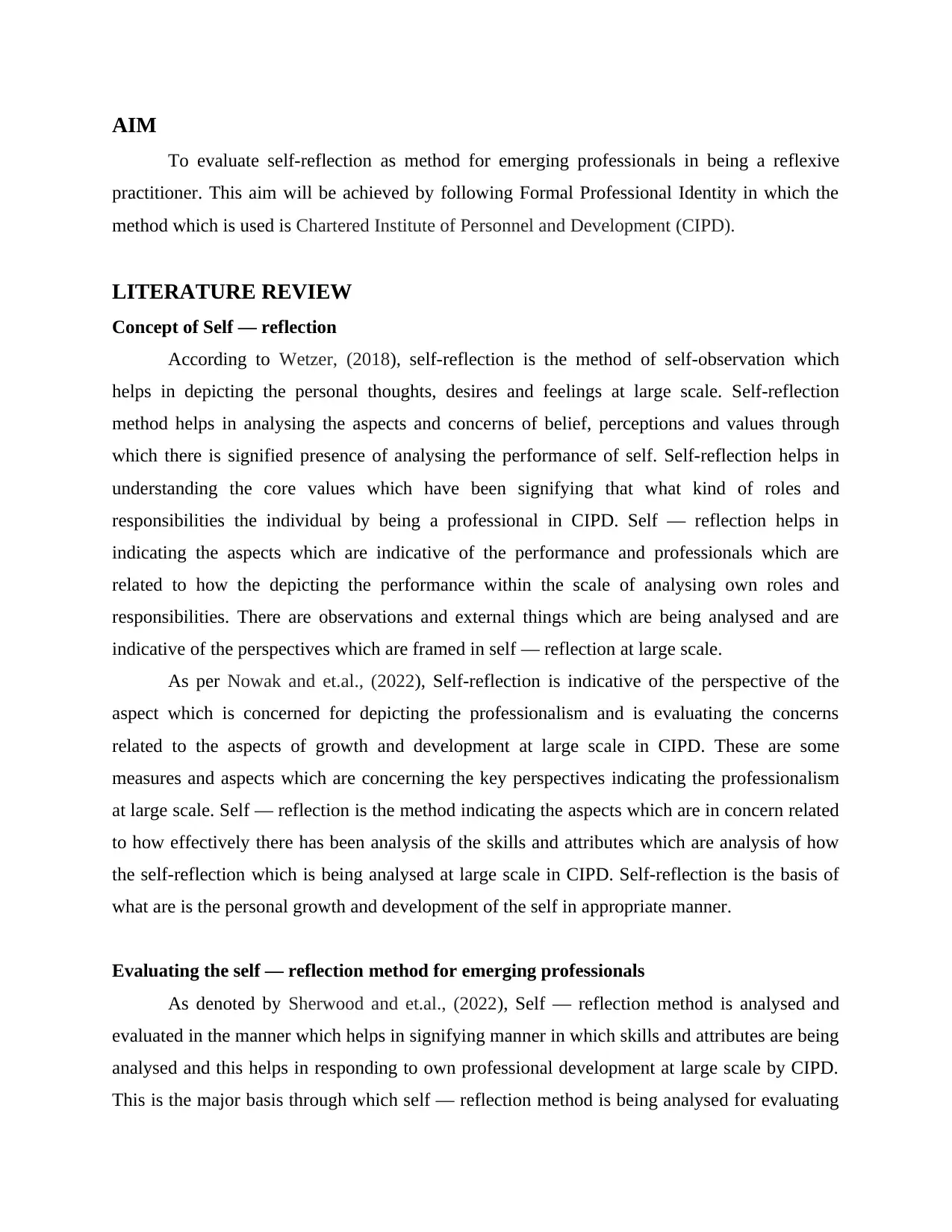
AIM
To evaluate self-reflection as method for emerging professionals in being a reflexive
practitioner. This aim will be achieved by following Formal Professional Identity in which the
method which is used is Chartered Institute of Personnel and Development (CIPD).
LITERATURE REVIEW
Concept of Self — reflection
According to Wetzer, (2018), self-reflection is the method of self-observation which
helps in depicting the personal thoughts, desires and feelings at large scale. Self-reflection
method helps in analysing the aspects and concerns of belief, perceptions and values through
which there is signified presence of analysing the performance of self. Self-reflection helps in
understanding the core values which have been signifying that what kind of roles and
responsibilities the individual by being a professional in CIPD. Self — reflection helps in
indicating the aspects which are indicative of the performance and professionals which are
related to how the depicting the performance within the scale of analysing own roles and
responsibilities. There are observations and external things which are being analysed and are
indicative of the perspectives which are framed in self — reflection at large scale.
As per Nowak and et.al., (2022), Self-reflection is indicative of the perspective of the
aspect which is concerned for depicting the professionalism and is evaluating the concerns
related to the aspects of growth and development at large scale in CIPD. These are some
measures and aspects which are concerning the key perspectives indicating the professionalism
at large scale. Self — reflection is the method indicating the aspects which are in concern related
to how effectively there has been analysis of the skills and attributes which are analysis of how
the self-reflection which is being analysed at large scale in CIPD. Self-reflection is the basis of
what are is the personal growth and development of the self in appropriate manner.
Evaluating the self — reflection method for emerging professionals
As denoted by Sherwood and et.al., (2022), Self — reflection method is analysed and
evaluated in the manner which helps in signifying manner in which skills and attributes are being
analysed and this helps in responding to own professional development at large scale by CIPD.
This is the major basis through which self — reflection method is being analysed for evaluating
To evaluate self-reflection as method for emerging professionals in being a reflexive
practitioner. This aim will be achieved by following Formal Professional Identity in which the
method which is used is Chartered Institute of Personnel and Development (CIPD).
LITERATURE REVIEW
Concept of Self — reflection
According to Wetzer, (2018), self-reflection is the method of self-observation which
helps in depicting the personal thoughts, desires and feelings at large scale. Self-reflection
method helps in analysing the aspects and concerns of belief, perceptions and values through
which there is signified presence of analysing the performance of self. Self-reflection helps in
understanding the core values which have been signifying that what kind of roles and
responsibilities the individual by being a professional in CIPD. Self — reflection helps in
indicating the aspects which are indicative of the performance and professionals which are
related to how the depicting the performance within the scale of analysing own roles and
responsibilities. There are observations and external things which are being analysed and are
indicative of the perspectives which are framed in self — reflection at large scale.
As per Nowak and et.al., (2022), Self-reflection is indicative of the perspective of the
aspect which is concerned for depicting the professionalism and is evaluating the concerns
related to the aspects of growth and development at large scale in CIPD. These are some
measures and aspects which are concerning the key perspectives indicating the professionalism
at large scale. Self — reflection is the method indicating the aspects which are in concern related
to how effectively there has been analysis of the skills and attributes which are analysis of how
the self-reflection which is being analysed at large scale in CIPD. Self-reflection is the basis of
what are is the personal growth and development of the self in appropriate manner.
Evaluating the self — reflection method for emerging professionals
As denoted by Sherwood and et.al., (2022), Self — reflection method is analysed and
evaluated in the manner which helps in signifying manner in which skills and attributes are being
analysed and this helps in responding to own professional development at large scale by CIPD.
This is the major basis through which self — reflection method is being analysed for evaluating
⊘ This is a preview!⊘
Do you want full access?
Subscribe today to unlock all pages.

Trusted by 1+ million students worldwide
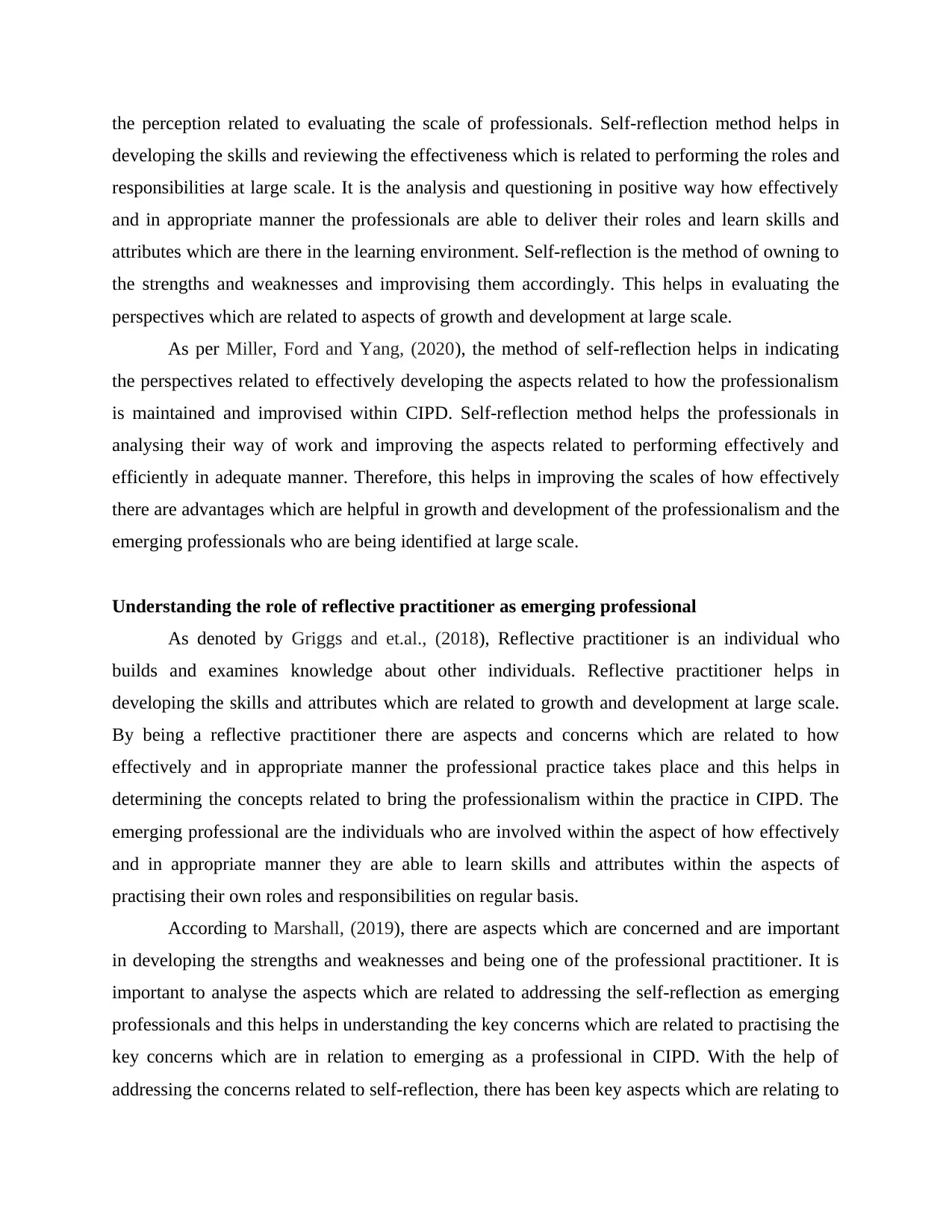
the perception related to evaluating the scale of professionals. Self-reflection method helps in
developing the skills and reviewing the effectiveness which is related to performing the roles and
responsibilities at large scale. It is the analysis and questioning in positive way how effectively
and in appropriate manner the professionals are able to deliver their roles and learn skills and
attributes which are there in the learning environment. Self-reflection is the method of owning to
the strengths and weaknesses and improvising them accordingly. This helps in evaluating the
perspectives which are related to aspects of growth and development at large scale.
As per Miller, Ford and Yang, (2020), the method of self-reflection helps in indicating
the perspectives related to effectively developing the aspects related to how the professionalism
is maintained and improvised within CIPD. Self-reflection method helps the professionals in
analysing their way of work and improving the aspects related to performing effectively and
efficiently in adequate manner. Therefore, this helps in improving the scales of how effectively
there are advantages which are helpful in growth and development of the professionalism and the
emerging professionals who are being identified at large scale.
Understanding the role of reflective practitioner as emerging professional
As denoted by Griggs and et.al., (2018), Reflective practitioner is an individual who
builds and examines knowledge about other individuals. Reflective practitioner helps in
developing the skills and attributes which are related to growth and development at large scale.
By being a reflective practitioner there are aspects and concerns which are related to how
effectively and in appropriate manner the professional practice takes place and this helps in
determining the concepts related to bring the professionalism within the practice in CIPD. The
emerging professional are the individuals who are involved within the aspect of how effectively
and in appropriate manner they are able to learn skills and attributes within the aspects of
practising their own roles and responsibilities on regular basis.
According to Marshall, (2019), there are aspects which are concerned and are important
in developing the strengths and weaknesses and being one of the professional practitioner. It is
important to analyse the aspects which are related to addressing the self-reflection as emerging
professionals and this helps in understanding the key concerns which are related to practising the
key concerns which are in relation to emerging as a professional in CIPD. With the help of
addressing the concerns related to self-reflection, there has been key aspects which are relating to
developing the skills and reviewing the effectiveness which is related to performing the roles and
responsibilities at large scale. It is the analysis and questioning in positive way how effectively
and in appropriate manner the professionals are able to deliver their roles and learn skills and
attributes which are there in the learning environment. Self-reflection is the method of owning to
the strengths and weaknesses and improvising them accordingly. This helps in evaluating the
perspectives which are related to aspects of growth and development at large scale.
As per Miller, Ford and Yang, (2020), the method of self-reflection helps in indicating
the perspectives related to effectively developing the aspects related to how the professionalism
is maintained and improvised within CIPD. Self-reflection method helps the professionals in
analysing their way of work and improving the aspects related to performing effectively and
efficiently in adequate manner. Therefore, this helps in improving the scales of how effectively
there are advantages which are helpful in growth and development of the professionalism and the
emerging professionals who are being identified at large scale.
Understanding the role of reflective practitioner as emerging professional
As denoted by Griggs and et.al., (2018), Reflective practitioner is an individual who
builds and examines knowledge about other individuals. Reflective practitioner helps in
developing the skills and attributes which are related to growth and development at large scale.
By being a reflective practitioner there are aspects and concerns which are related to how
effectively and in appropriate manner the professional practice takes place and this helps in
determining the concepts related to bring the professionalism within the practice in CIPD. The
emerging professional are the individuals who are involved within the aspect of how effectively
and in appropriate manner they are able to learn skills and attributes within the aspects of
practising their own roles and responsibilities on regular basis.
According to Marshall, (2019), there are aspects which are concerned and are important
in developing the strengths and weaknesses and being one of the professional practitioner. It is
important to analyse the aspects which are related to addressing the self-reflection as emerging
professionals and this helps in understanding the key concerns which are related to practising the
key concerns which are in relation to emerging as a professional in CIPD. With the help of
addressing the concerns related to self-reflection, there has been key aspects which are relating to
Paraphrase This Document
Need a fresh take? Get an instant paraphrase of this document with our AI Paraphraser
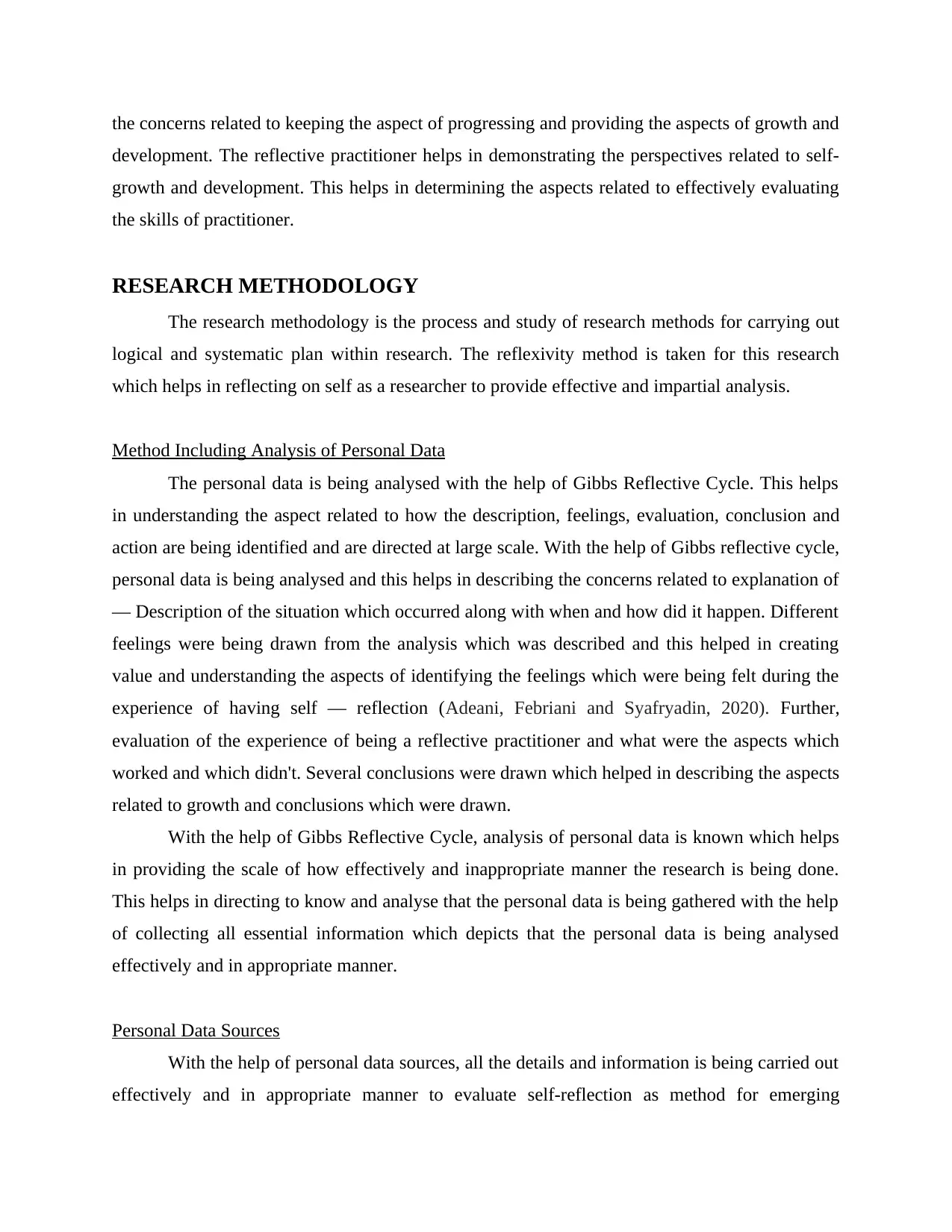
the concerns related to keeping the aspect of progressing and providing the aspects of growth and
development. The reflective practitioner helps in demonstrating the perspectives related to self-
growth and development. This helps in determining the aspects related to effectively evaluating
the skills of practitioner.
RESEARCH METHODOLOGY
The research methodology is the process and study of research methods for carrying out
logical and systematic plan within research. The reflexivity method is taken for this research
which helps in reflecting on self as a researcher to provide effective and impartial analysis.
Method Including Analysis of Personal Data
The personal data is being analysed with the help of Gibbs Reflective Cycle. This helps
in understanding the aspect related to how the description, feelings, evaluation, conclusion and
action are being identified and are directed at large scale. With the help of Gibbs reflective cycle,
personal data is being analysed and this helps in describing the concerns related to explanation of
— Description of the situation which occurred along with when and how did it happen. Different
feelings were being drawn from the analysis which was described and this helped in creating
value and understanding the aspects of identifying the feelings which were being felt during the
experience of having self — reflection (Adeani, Febriani and Syafryadin, 2020). Further,
evaluation of the experience of being a reflective practitioner and what were the aspects which
worked and which didn't. Several conclusions were drawn which helped in describing the aspects
related to growth and conclusions which were drawn.
With the help of Gibbs Reflective Cycle, analysis of personal data is known which helps
in providing the scale of how effectively and inappropriate manner the research is being done.
This helps in directing to know and analyse that the personal data is being gathered with the help
of collecting all essential information which depicts that the personal data is being analysed
effectively and in appropriate manner.
Personal Data Sources
With the help of personal data sources, all the details and information is being carried out
effectively and in appropriate manner to evaluate self-reflection as method for emerging
development. The reflective practitioner helps in demonstrating the perspectives related to self-
growth and development. This helps in determining the aspects related to effectively evaluating
the skills of practitioner.
RESEARCH METHODOLOGY
The research methodology is the process and study of research methods for carrying out
logical and systematic plan within research. The reflexivity method is taken for this research
which helps in reflecting on self as a researcher to provide effective and impartial analysis.
Method Including Analysis of Personal Data
The personal data is being analysed with the help of Gibbs Reflective Cycle. This helps
in understanding the aspect related to how the description, feelings, evaluation, conclusion and
action are being identified and are directed at large scale. With the help of Gibbs reflective cycle,
personal data is being analysed and this helps in describing the concerns related to explanation of
— Description of the situation which occurred along with when and how did it happen. Different
feelings were being drawn from the analysis which was described and this helped in creating
value and understanding the aspects of identifying the feelings which were being felt during the
experience of having self — reflection (Adeani, Febriani and Syafryadin, 2020). Further,
evaluation of the experience of being a reflective practitioner and what were the aspects which
worked and which didn't. Several conclusions were drawn which helped in describing the aspects
related to growth and conclusions which were drawn.
With the help of Gibbs Reflective Cycle, analysis of personal data is known which helps
in providing the scale of how effectively and inappropriate manner the research is being done.
This helps in directing to know and analyse that the personal data is being gathered with the help
of collecting all essential information which depicts that the personal data is being analysed
effectively and in appropriate manner.
Personal Data Sources
With the help of personal data sources, all the details and information is being carried out
effectively and in appropriate manner to evaluate self-reflection as method for emerging
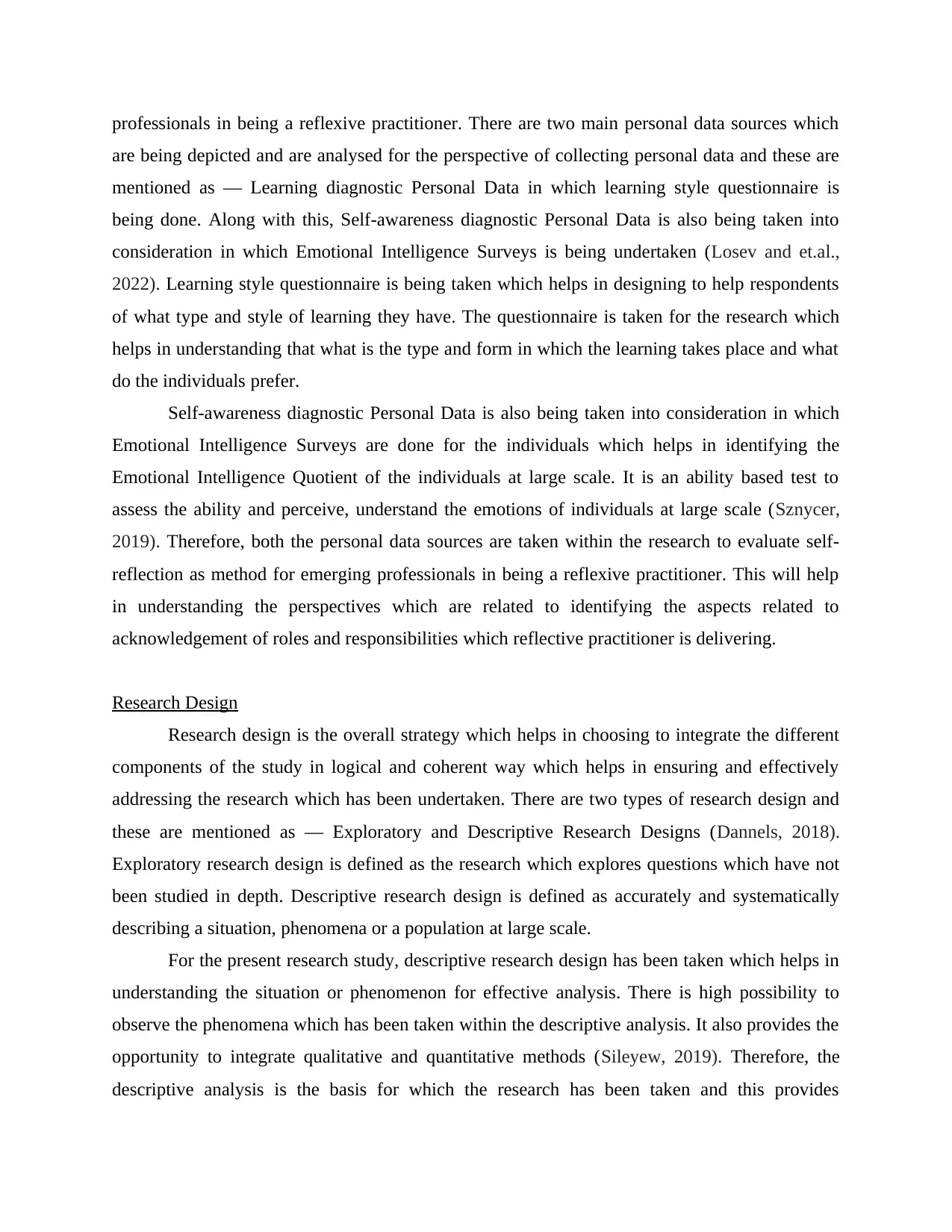
professionals in being a reflexive practitioner. There are two main personal data sources which
are being depicted and are analysed for the perspective of collecting personal data and these are
mentioned as — Learning diagnostic Personal Data in which learning style questionnaire is
being done. Along with this, Self‐awareness diagnostic Personal Data is also being taken into
consideration in which Emotional Intelligence Surveys is being undertaken (Losev and et.al.,
2022). Learning style questionnaire is being taken which helps in designing to help respondents
of what type and style of learning they have. The questionnaire is taken for the research which
helps in understanding that what is the type and form in which the learning takes place and what
do the individuals prefer.
Self‐awareness diagnostic Personal Data is also being taken into consideration in which
Emotional Intelligence Surveys are done for the individuals which helps in identifying the
Emotional Intelligence Quotient of the individuals at large scale. It is an ability based test to
assess the ability and perceive, understand the emotions of individuals at large scale (Sznycer,
2019). Therefore, both the personal data sources are taken within the research to evaluate self-
reflection as method for emerging professionals in being a reflexive practitioner. This will help
in understanding the perspectives which are related to identifying the aspects related to
acknowledgement of roles and responsibilities which reflective practitioner is delivering.
Research Design
Research design is the overall strategy which helps in choosing to integrate the different
components of the study in logical and coherent way which helps in ensuring and effectively
addressing the research which has been undertaken. There are two types of research design and
these are mentioned as — Exploratory and Descriptive Research Designs (Dannels, 2018).
Exploratory research design is defined as the research which explores questions which have not
been studied in depth. Descriptive research design is defined as accurately and systematically
describing a situation, phenomena or a population at large scale.
For the present research study, descriptive research design has been taken which helps in
understanding the situation or phenomenon for effective analysis. There is high possibility to
observe the phenomena which has been taken within the descriptive analysis. It also provides the
opportunity to integrate qualitative and quantitative methods (Sileyew, 2019). Therefore, the
descriptive analysis is the basis for which the research has been taken and this provides
are being depicted and are analysed for the perspective of collecting personal data and these are
mentioned as — Learning diagnostic Personal Data in which learning style questionnaire is
being done. Along with this, Self‐awareness diagnostic Personal Data is also being taken into
consideration in which Emotional Intelligence Surveys is being undertaken (Losev and et.al.,
2022). Learning style questionnaire is being taken which helps in designing to help respondents
of what type and style of learning they have. The questionnaire is taken for the research which
helps in understanding that what is the type and form in which the learning takes place and what
do the individuals prefer.
Self‐awareness diagnostic Personal Data is also being taken into consideration in which
Emotional Intelligence Surveys are done for the individuals which helps in identifying the
Emotional Intelligence Quotient of the individuals at large scale. It is an ability based test to
assess the ability and perceive, understand the emotions of individuals at large scale (Sznycer,
2019). Therefore, both the personal data sources are taken within the research to evaluate self-
reflection as method for emerging professionals in being a reflexive practitioner. This will help
in understanding the perspectives which are related to identifying the aspects related to
acknowledgement of roles and responsibilities which reflective practitioner is delivering.
Research Design
Research design is the overall strategy which helps in choosing to integrate the different
components of the study in logical and coherent way which helps in ensuring and effectively
addressing the research which has been undertaken. There are two types of research design and
these are mentioned as — Exploratory and Descriptive Research Designs (Dannels, 2018).
Exploratory research design is defined as the research which explores questions which have not
been studied in depth. Descriptive research design is defined as accurately and systematically
describing a situation, phenomena or a population at large scale.
For the present research study, descriptive research design has been taken which helps in
understanding the situation or phenomenon for effective analysis. There is high possibility to
observe the phenomena which has been taken within the descriptive analysis. It also provides the
opportunity to integrate qualitative and quantitative methods (Sileyew, 2019). Therefore, the
descriptive analysis is the basis for which the research has been taken and this provides
⊘ This is a preview!⊘
Do you want full access?
Subscribe today to unlock all pages.

Trusted by 1+ million students worldwide
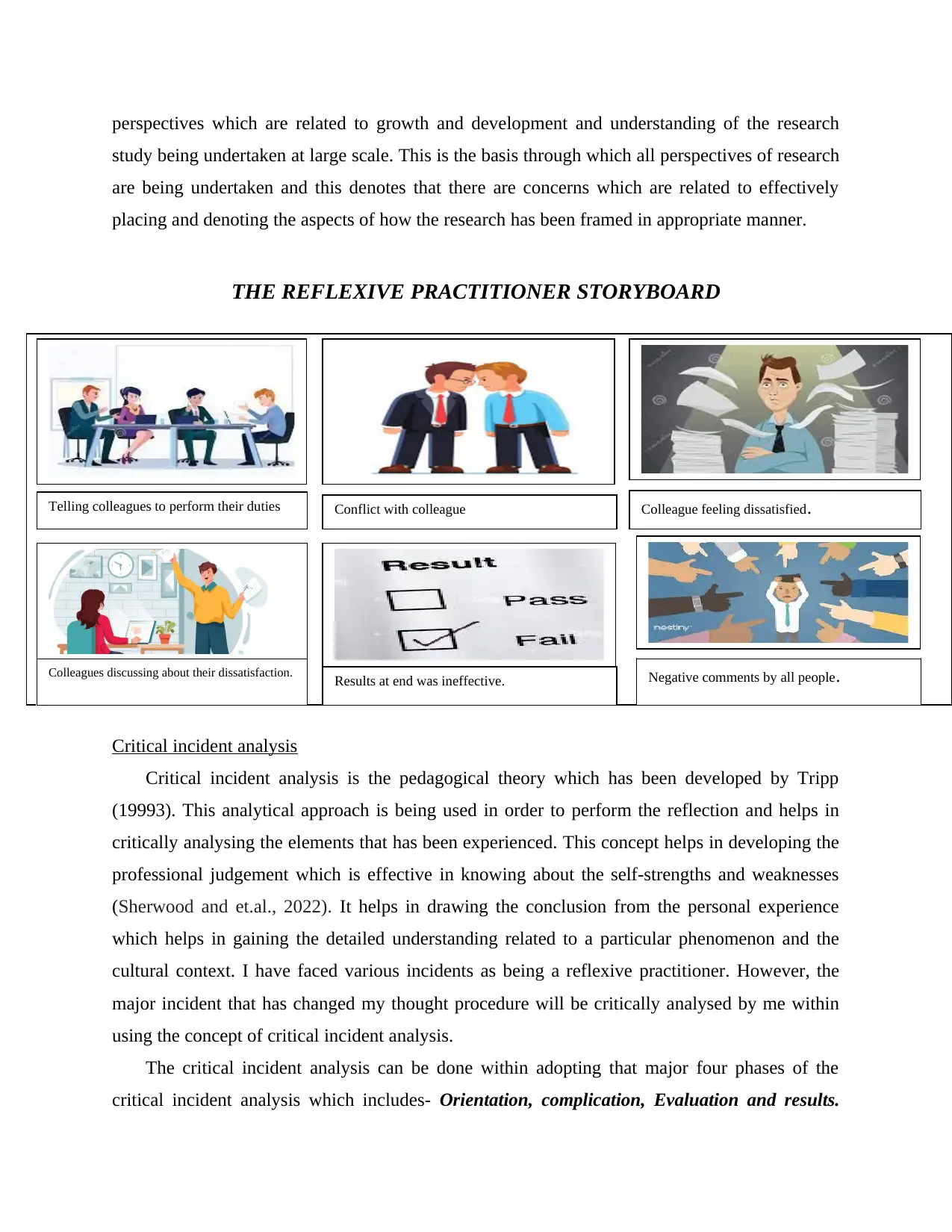
perspectives which are related to growth and development and understanding of the research
study being undertaken at large scale. This is the basis through which all perspectives of research
are being undertaken and this denotes that there are concerns which are related to effectively
placing and denoting the aspects of how the research has been framed in appropriate manner.
THE REFLEXIVE PRACTITIONER STORYBOARD
Critical incident analysis
Critical incident analysis is the pedagogical theory which has been developed by Tripp
(19993). This analytical approach is being used in order to perform the reflection and helps in
critically analysing the elements that has been experienced. This concept helps in developing the
professional judgement which is effective in knowing about the self-strengths and weaknesses
(Sherwood and et.al., 2022). It helps in drawing the conclusion from the personal experience
which helps in gaining the detailed understanding related to a particular phenomenon and the
cultural context. I have faced various incidents as being a reflexive practitioner. However, the
major incident that has changed my thought procedure will be critically analysed by me within
using the concept of critical incident analysis.
The critical incident analysis can be done within adopting that major four phases of the
critical incident analysis which includes- Orientation, complication, Evaluation and results.
Telling colleagues to perform their duties Conflict with colleague Colleague feeling dissatisfied.
Colleagues discussing about their dissatisfaction. Results at end was ineffective. Negative comments by all people.
study being undertaken at large scale. This is the basis through which all perspectives of research
are being undertaken and this denotes that there are concerns which are related to effectively
placing and denoting the aspects of how the research has been framed in appropriate manner.
THE REFLEXIVE PRACTITIONER STORYBOARD
Critical incident analysis
Critical incident analysis is the pedagogical theory which has been developed by Tripp
(19993). This analytical approach is being used in order to perform the reflection and helps in
critically analysing the elements that has been experienced. This concept helps in developing the
professional judgement which is effective in knowing about the self-strengths and weaknesses
(Sherwood and et.al., 2022). It helps in drawing the conclusion from the personal experience
which helps in gaining the detailed understanding related to a particular phenomenon and the
cultural context. I have faced various incidents as being a reflexive practitioner. However, the
major incident that has changed my thought procedure will be critically analysed by me within
using the concept of critical incident analysis.
The critical incident analysis can be done within adopting that major four phases of the
critical incident analysis which includes- Orientation, complication, Evaluation and results.
Telling colleagues to perform their duties Conflict with colleague Colleague feeling dissatisfied.
Colleagues discussing about their dissatisfaction. Results at end was ineffective. Negative comments by all people.
Paraphrase This Document
Need a fresh take? Get an instant paraphrase of this document with our AI Paraphraser
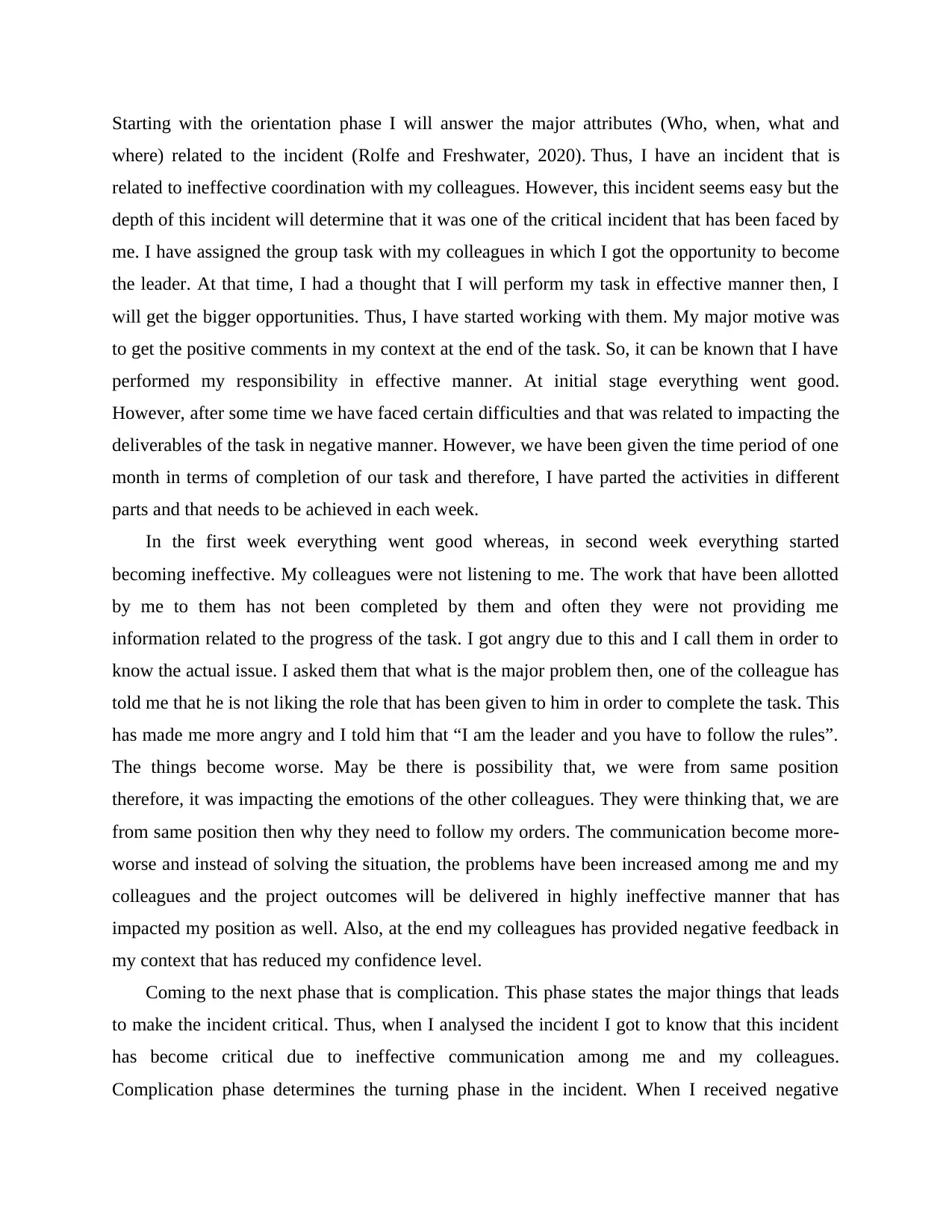
Starting with the orientation phase I will answer the major attributes (Who, when, what and
where) related to the incident (Rolfe and Freshwater, 2020). Thus, I have an incident that is
related to ineffective coordination with my colleagues. However, this incident seems easy but the
depth of this incident will determine that it was one of the critical incident that has been faced by
me. I have assigned the group task with my colleagues in which I got the opportunity to become
the leader. At that time, I had a thought that I will perform my task in effective manner then, I
will get the bigger opportunities. Thus, I have started working with them. My major motive was
to get the positive comments in my context at the end of the task. So, it can be known that I have
performed my responsibility in effective manner. At initial stage everything went good.
However, after some time we have faced certain difficulties and that was related to impacting the
deliverables of the task in negative manner. However, we have been given the time period of one
month in terms of completion of our task and therefore, I have parted the activities in different
parts and that needs to be achieved in each week.
In the first week everything went good whereas, in second week everything started
becoming ineffective. My colleagues were not listening to me. The work that have been allotted
by me to them has not been completed by them and often they were not providing me
information related to the progress of the task. I got angry due to this and I call them in order to
know the actual issue. I asked them that what is the major problem then, one of the colleague has
told me that he is not liking the role that has been given to him in order to complete the task. This
has made me more angry and I told him that “I am the leader and you have to follow the rules”.
The things become worse. May be there is possibility that, we were from same position
therefore, it was impacting the emotions of the other colleagues. They were thinking that, we are
from same position then why they need to follow my orders. The communication become more-
worse and instead of solving the situation, the problems have been increased among me and my
colleagues and the project outcomes will be delivered in highly ineffective manner that has
impacted my position as well. Also, at the end my colleagues has provided negative feedback in
my context that has reduced my confidence level.
Coming to the next phase that is complication. This phase states the major things that leads
to make the incident critical. Thus, when I analysed the incident I got to know that this incident
has become critical due to ineffective communication among me and my colleagues.
Complication phase determines the turning phase in the incident. When I received negative
where) related to the incident (Rolfe and Freshwater, 2020). Thus, I have an incident that is
related to ineffective coordination with my colleagues. However, this incident seems easy but the
depth of this incident will determine that it was one of the critical incident that has been faced by
me. I have assigned the group task with my colleagues in which I got the opportunity to become
the leader. At that time, I had a thought that I will perform my task in effective manner then, I
will get the bigger opportunities. Thus, I have started working with them. My major motive was
to get the positive comments in my context at the end of the task. So, it can be known that I have
performed my responsibility in effective manner. At initial stage everything went good.
However, after some time we have faced certain difficulties and that was related to impacting the
deliverables of the task in negative manner. However, we have been given the time period of one
month in terms of completion of our task and therefore, I have parted the activities in different
parts and that needs to be achieved in each week.
In the first week everything went good whereas, in second week everything started
becoming ineffective. My colleagues were not listening to me. The work that have been allotted
by me to them has not been completed by them and often they were not providing me
information related to the progress of the task. I got angry due to this and I call them in order to
know the actual issue. I asked them that what is the major problem then, one of the colleague has
told me that he is not liking the role that has been given to him in order to complete the task. This
has made me more angry and I told him that “I am the leader and you have to follow the rules”.
The things become worse. May be there is possibility that, we were from same position
therefore, it was impacting the emotions of the other colleagues. They were thinking that, we are
from same position then why they need to follow my orders. The communication become more-
worse and instead of solving the situation, the problems have been increased among me and my
colleagues and the project outcomes will be delivered in highly ineffective manner that has
impacted my position as well. Also, at the end my colleagues has provided negative feedback in
my context that has reduced my confidence level.
Coming to the next phase that is complication. This phase states the major things that leads
to make the incident critical. Thus, when I analysed the incident I got to know that this incident
has become critical due to ineffective communication among me and my colleagues.
Complication phase determines the turning phase in the incident. When I received negative
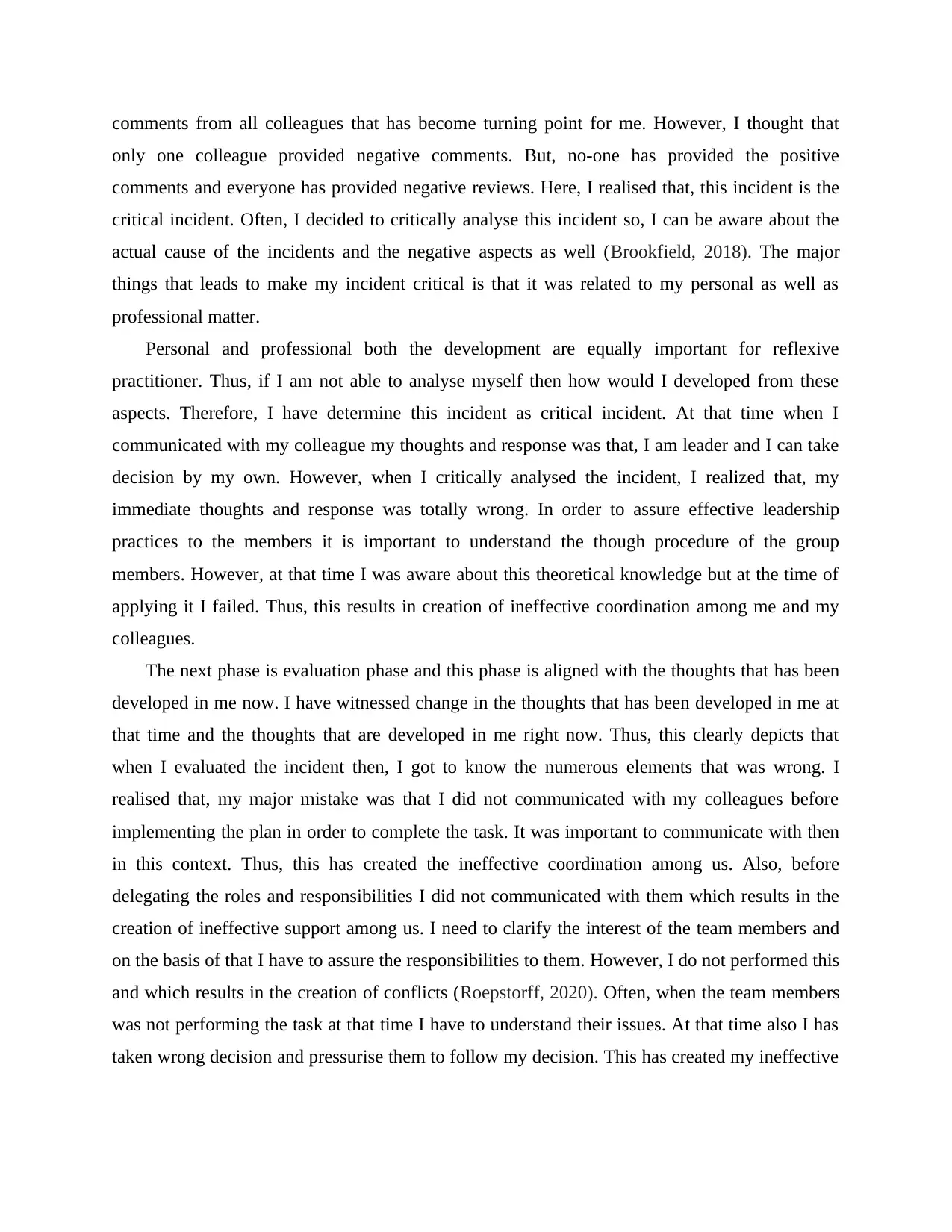
comments from all colleagues that has become turning point for me. However, I thought that
only one colleague provided negative comments. But, no-one has provided the positive
comments and everyone has provided negative reviews. Here, I realised that, this incident is the
critical incident. Often, I decided to critically analyse this incident so, I can be aware about the
actual cause of the incidents and the negative aspects as well (Brookfield, 2018). The major
things that leads to make my incident critical is that it was related to my personal as well as
professional matter.
Personal and professional both the development are equally important for reflexive
practitioner. Thus, if I am not able to analyse myself then how would I developed from these
aspects. Therefore, I have determine this incident as critical incident. At that time when I
communicated with my colleague my thoughts and response was that, I am leader and I can take
decision by my own. However, when I critically analysed the incident, I realized that, my
immediate thoughts and response was totally wrong. In order to assure effective leadership
practices to the members it is important to understand the though procedure of the group
members. However, at that time I was aware about this theoretical knowledge but at the time of
applying it I failed. Thus, this results in creation of ineffective coordination among me and my
colleagues.
The next phase is evaluation phase and this phase is aligned with the thoughts that has been
developed in me now. I have witnessed change in the thoughts that has been developed in me at
that time and the thoughts that are developed in me right now. Thus, this clearly depicts that
when I evaluated the incident then, I got to know the numerous elements that was wrong. I
realised that, my major mistake was that I did not communicated with my colleagues before
implementing the plan in order to complete the task. It was important to communicate with then
in this context. Thus, this has created the ineffective coordination among us. Also, before
delegating the roles and responsibilities I did not communicated with them which results in the
creation of ineffective support among us. I need to clarify the interest of the team members and
on the basis of that I have to assure the responsibilities to them. However, I do not performed this
and which results in the creation of conflicts (Roepstorff, 2020). Often, when the team members
was not performing the task at that time I have to understand their issues. At that time also I has
taken wrong decision and pressurise them to follow my decision. This has created my ineffective
only one colleague provided negative comments. But, no-one has provided the positive
comments and everyone has provided negative reviews. Here, I realised that, this incident is the
critical incident. Often, I decided to critically analyse this incident so, I can be aware about the
actual cause of the incidents and the negative aspects as well (Brookfield, 2018). The major
things that leads to make my incident critical is that it was related to my personal as well as
professional matter.
Personal and professional both the development are equally important for reflexive
practitioner. Thus, if I am not able to analyse myself then how would I developed from these
aspects. Therefore, I have determine this incident as critical incident. At that time when I
communicated with my colleague my thoughts and response was that, I am leader and I can take
decision by my own. However, when I critically analysed the incident, I realized that, my
immediate thoughts and response was totally wrong. In order to assure effective leadership
practices to the members it is important to understand the though procedure of the group
members. However, at that time I was aware about this theoretical knowledge but at the time of
applying it I failed. Thus, this results in creation of ineffective coordination among me and my
colleagues.
The next phase is evaluation phase and this phase is aligned with the thoughts that has been
developed in me now. I have witnessed change in the thoughts that has been developed in me at
that time and the thoughts that are developed in me right now. Thus, this clearly depicts that
when I evaluated the incident then, I got to know the numerous elements that was wrong. I
realised that, my major mistake was that I did not communicated with my colleagues before
implementing the plan in order to complete the task. It was important to communicate with then
in this context. Thus, this has created the ineffective coordination among us. Also, before
delegating the roles and responsibilities I did not communicated with them which results in the
creation of ineffective support among us. I need to clarify the interest of the team members and
on the basis of that I have to assure the responsibilities to them. However, I do not performed this
and which results in the creation of conflicts (Roepstorff, 2020). Often, when the team members
was not performing the task at that time I have to understand their issues. At that time also I has
taken wrong decision and pressurise them to follow my decision. This has created my ineffective
⊘ This is a preview!⊘
Do you want full access?
Subscribe today to unlock all pages.

Trusted by 1+ million students worldwide
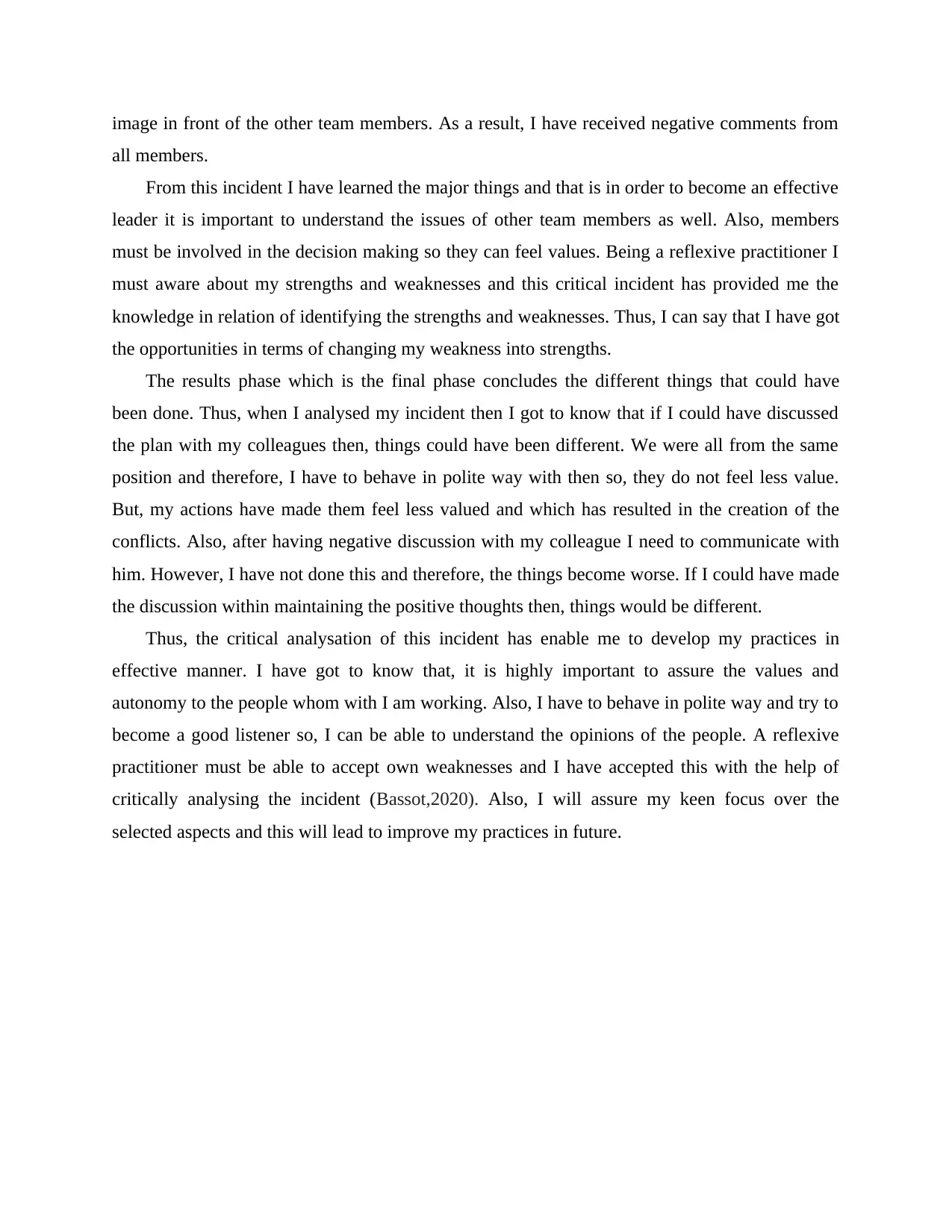
image in front of the other team members. As a result, I have received negative comments from
all members.
From this incident I have learned the major things and that is in order to become an effective
leader it is important to understand the issues of other team members as well. Also, members
must be involved in the decision making so they can feel values. Being a reflexive practitioner I
must aware about my strengths and weaknesses and this critical incident has provided me the
knowledge in relation of identifying the strengths and weaknesses. Thus, I can say that I have got
the opportunities in terms of changing my weakness into strengths.
The results phase which is the final phase concludes the different things that could have
been done. Thus, when I analysed my incident then I got to know that if I could have discussed
the plan with my colleagues then, things could have been different. We were all from the same
position and therefore, I have to behave in polite way with then so, they do not feel less value.
But, my actions have made them feel less valued and which has resulted in the creation of the
conflicts. Also, after having negative discussion with my colleague I need to communicate with
him. However, I have not done this and therefore, the things become worse. If I could have made
the discussion within maintaining the positive thoughts then, things would be different.
Thus, the critical analysation of this incident has enable me to develop my practices in
effective manner. I have got to know that, it is highly important to assure the values and
autonomy to the people whom with I am working. Also, I have to behave in polite way and try to
become a good listener so, I can be able to understand the opinions of the people. A reflexive
practitioner must be able to accept own weaknesses and I have accepted this with the help of
critically analysing the incident (Bassot,2020). Also, I will assure my keen focus over the
selected aspects and this will lead to improve my practices in future.
all members.
From this incident I have learned the major things and that is in order to become an effective
leader it is important to understand the issues of other team members as well. Also, members
must be involved in the decision making so they can feel values. Being a reflexive practitioner I
must aware about my strengths and weaknesses and this critical incident has provided me the
knowledge in relation of identifying the strengths and weaknesses. Thus, I can say that I have got
the opportunities in terms of changing my weakness into strengths.
The results phase which is the final phase concludes the different things that could have
been done. Thus, when I analysed my incident then I got to know that if I could have discussed
the plan with my colleagues then, things could have been different. We were all from the same
position and therefore, I have to behave in polite way with then so, they do not feel less value.
But, my actions have made them feel less valued and which has resulted in the creation of the
conflicts. Also, after having negative discussion with my colleague I need to communicate with
him. However, I have not done this and therefore, the things become worse. If I could have made
the discussion within maintaining the positive thoughts then, things would be different.
Thus, the critical analysation of this incident has enable me to develop my practices in
effective manner. I have got to know that, it is highly important to assure the values and
autonomy to the people whom with I am working. Also, I have to behave in polite way and try to
become a good listener so, I can be able to understand the opinions of the people. A reflexive
practitioner must be able to accept own weaknesses and I have accepted this with the help of
critically analysing the incident (Bassot,2020). Also, I will assure my keen focus over the
selected aspects and this will lead to improve my practices in future.
Paraphrase This Document
Need a fresh take? Get an instant paraphrase of this document with our AI Paraphraser
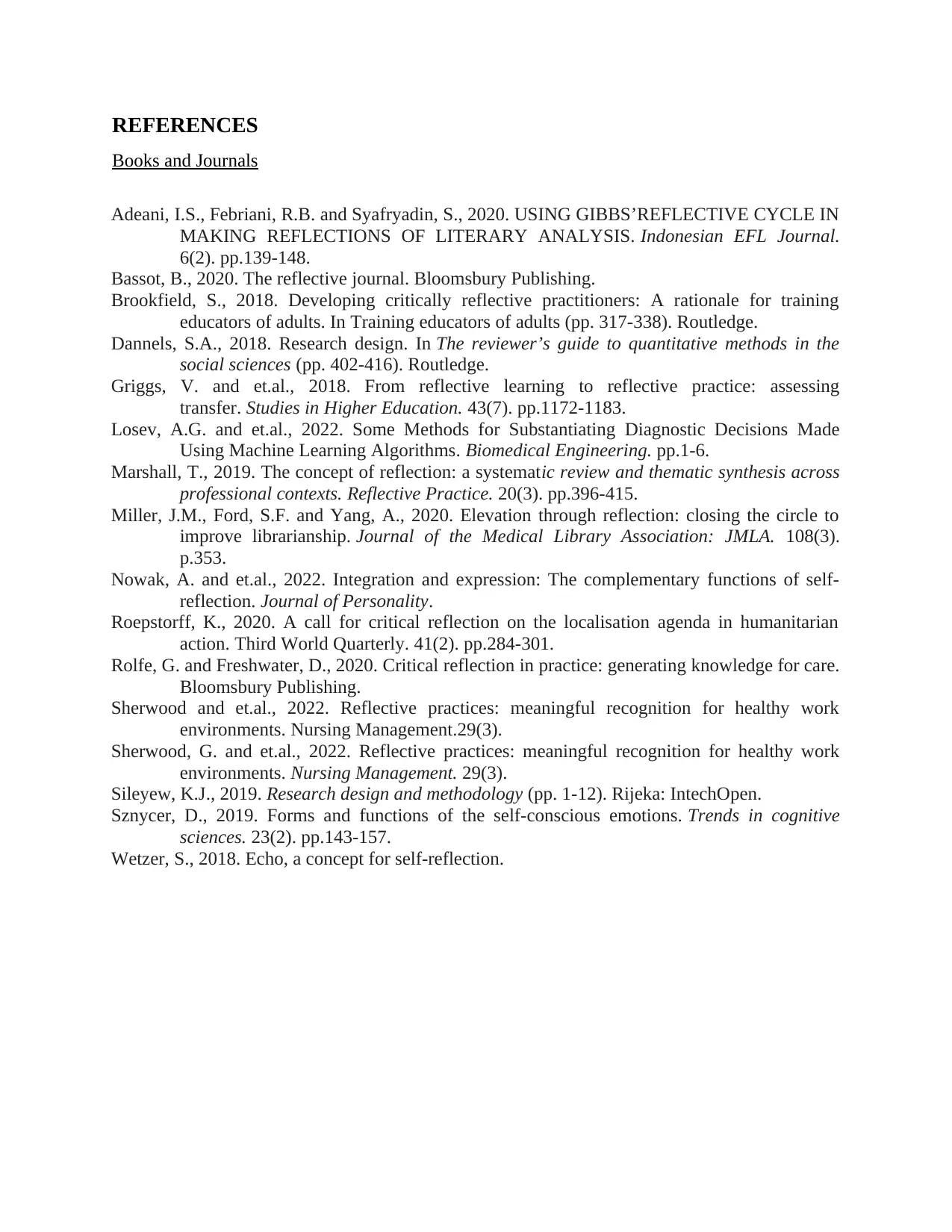
REFERENCES
Books and Journals
Adeani, I.S., Febriani, R.B. and Syafryadin, S., 2020. USING GIBBS’REFLECTIVE CYCLE IN
MAKING REFLECTIONS OF LITERARY ANALYSIS. Indonesian EFL Journal.
6(2). pp.139-148.
Bassot, B., 2020. The reflective journal. Bloomsbury Publishing.
Brookfield, S., 2018. Developing critically reflective practitioners: A rationale for training
educators of adults. In Training educators of adults (pp. 317-338). Routledge.
Dannels, S.A., 2018. Research design. In The reviewer’s guide to quantitative methods in the
social sciences (pp. 402-416). Routledge.
Griggs, V. and et.al., 2018. From reflective learning to reflective practice: assessing
transfer. Studies in Higher Education. 43(7). pp.1172-1183.
Losev, A.G. and et.al., 2022. Some Methods for Substantiating Diagnostic Decisions Made
Using Machine Learning Algorithms. Biomedical Engineering. pp.1-6.
Marshall, T., 2019. The concept of reflection: a systematic review and thematic synthesis across
professional contexts. Reflective Practice. 20(3). pp.396-415.
Miller, J.M., Ford, S.F. and Yang, A., 2020. Elevation through reflection: closing the circle to
improve librarianship. Journal of the Medical Library Association: JMLA. 108(3).
p.353.
Nowak, A. and et.al., 2022. Integration and expression: The complementary functions of self‐
reflection. Journal of Personality.
Roepstorff, K., 2020. A call for critical reflection on the localisation agenda in humanitarian
action. Third World Quarterly. 41(2). pp.284-301.
Rolfe, G. and Freshwater, D., 2020. Critical reflection in practice: generating knowledge for care.
Bloomsbury Publishing.
Sherwood and et.al., 2022. Reflective practices: meaningful recognition for healthy work
environments. Nursing Management.29(3).
Sherwood, G. and et.al., 2022. Reflective practices: meaningful recognition for healthy work
environments. Nursing Management. 29(3).
Sileyew, K.J., 2019. Research design and methodology (pp. 1-12). Rijeka: IntechOpen.
Sznycer, D., 2019. Forms and functions of the self-conscious emotions. Trends in cognitive
sciences. 23(2). pp.143-157.
Wetzer, S., 2018. Echo, a concept for self-reflection.
Books and Journals
Adeani, I.S., Febriani, R.B. and Syafryadin, S., 2020. USING GIBBS’REFLECTIVE CYCLE IN
MAKING REFLECTIONS OF LITERARY ANALYSIS. Indonesian EFL Journal.
6(2). pp.139-148.
Bassot, B., 2020. The reflective journal. Bloomsbury Publishing.
Brookfield, S., 2018. Developing critically reflective practitioners: A rationale for training
educators of adults. In Training educators of adults (pp. 317-338). Routledge.
Dannels, S.A., 2018. Research design. In The reviewer’s guide to quantitative methods in the
social sciences (pp. 402-416). Routledge.
Griggs, V. and et.al., 2018. From reflective learning to reflective practice: assessing
transfer. Studies in Higher Education. 43(7). pp.1172-1183.
Losev, A.G. and et.al., 2022. Some Methods for Substantiating Diagnostic Decisions Made
Using Machine Learning Algorithms. Biomedical Engineering. pp.1-6.
Marshall, T., 2019. The concept of reflection: a systematic review and thematic synthesis across
professional contexts. Reflective Practice. 20(3). pp.396-415.
Miller, J.M., Ford, S.F. and Yang, A., 2020. Elevation through reflection: closing the circle to
improve librarianship. Journal of the Medical Library Association: JMLA. 108(3).
p.353.
Nowak, A. and et.al., 2022. Integration and expression: The complementary functions of self‐
reflection. Journal of Personality.
Roepstorff, K., 2020. A call for critical reflection on the localisation agenda in humanitarian
action. Third World Quarterly. 41(2). pp.284-301.
Rolfe, G. and Freshwater, D., 2020. Critical reflection in practice: generating knowledge for care.
Bloomsbury Publishing.
Sherwood and et.al., 2022. Reflective practices: meaningful recognition for healthy work
environments. Nursing Management.29(3).
Sherwood, G. and et.al., 2022. Reflective practices: meaningful recognition for healthy work
environments. Nursing Management. 29(3).
Sileyew, K.J., 2019. Research design and methodology (pp. 1-12). Rijeka: IntechOpen.
Sznycer, D., 2019. Forms and functions of the self-conscious emotions. Trends in cognitive
sciences. 23(2). pp.143-157.
Wetzer, S., 2018. Echo, a concept for self-reflection.

1
⊘ This is a preview!⊘
Do you want full access?
Subscribe today to unlock all pages.

Trusted by 1+ million students worldwide
1 out of 12
Related Documents
Your All-in-One AI-Powered Toolkit for Academic Success.
+13062052269
info@desklib.com
Available 24*7 on WhatsApp / Email
![[object Object]](/_next/static/media/star-bottom.7253800d.svg)
Unlock your academic potential
Copyright © 2020–2025 A2Z Services. All Rights Reserved. Developed and managed by ZUCOL.





